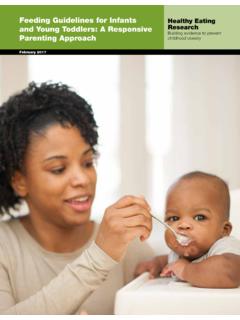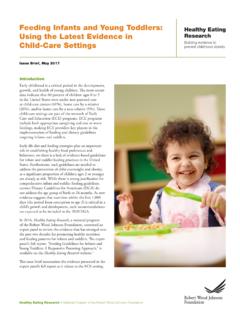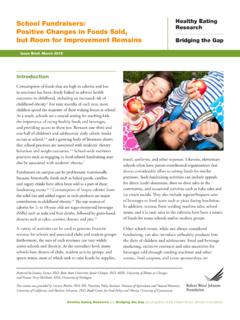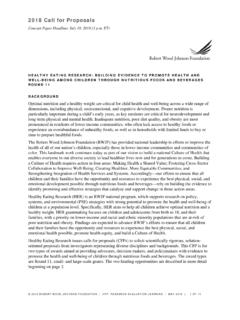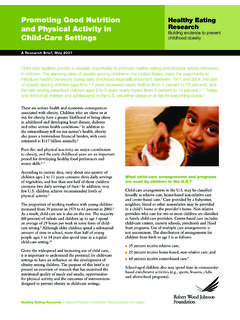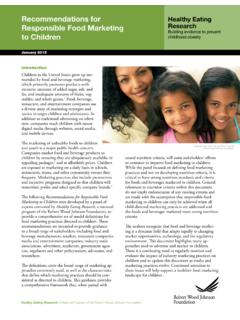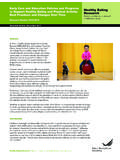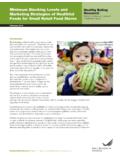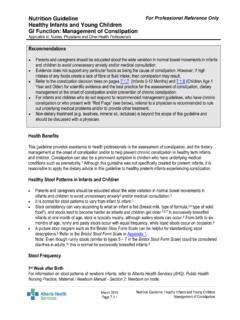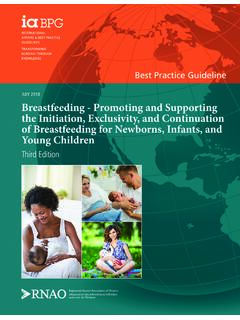Transcription of Healthy Eating Research Nutrition Guidelines for the ...
1 March 2020 Healthy Eating Research A National Program of the Robert Wood Johnson FoundationHealthy Eating Research Nutrition Guidelines for the Charitable Food System Healthy Eating ResearchHealthy Eating Research Nutrition Guidelines for the Charitable Food System | March 2020 1 Healthy Eating Research Nutrition Guidelines for the Charitable Food System March 2020 Healthy Eating Research2 Healthy Eating Research Nutrition Guidelines for the Charitable Food System | March 2020 Expert Panel Co-ChairsHilary Seligman, MD, MASA ssociate Professor of Medicine and of Epidemiology and BiostatisticsDirector, Food Policy, Health and Hunger Program, Center for Vulnerable PopulationsUniversity of California, San FranciscoMarlene Schwartz, PhDDirector, Rudd Center for Obesity & Food PolicyProfessor, Human Development and Family Sciences University of ConnecticutPanel Conveners Mary Story, PhD, RDDirector, Healthy Eating ResearchProfessor, Global Health and Family Medicine and Community HealthDuke Global Health InstituteDuke University Megan Lott, MPH, RDND eputy Director, Healthy Eating ResearchDuke Global Health InstituteDuke UniversityPanel SupportRonli Levi, MPH, RDResearch Analyst, Center for Vulnerable PopulationsUniversity of California.
2 San FranciscoKirsten Arm, MPH, RDNR esearch Analyst, Healthy Eating ResearchDuke Global Health InstituteLauren Dawson, MPHC ommunications Associate, Healthy Eating ResearchUniversity of Minnesota School of Public HealthEmily Welker Duffy, MPH, RDSenior Research Associate, Healthy Eating ResearchDuke Global Health InstituteExpert Panel MembersGerry Brisson, MA President and CEO of Gleaners Community Food Bank of Southeast Michigan Elizabeth Campbell, MA, RDNS enior Director, Legislative and Government Affairs, Academy of Nutrition and DieteticsGayle Carlson, MAEDCEO, Montana Food Bank Network Caitlin Caspi, ScDAssistant Professor, Department of Family Medicine and Community Health University of Minnesota Marla FeldmanSenior Program Director, MAZON: A Jewish Response to HungerTracy Fox, MPH, RDPresident, Food, Nutrition and Policy Consultants, LLC Karen Hanner, MM Vice President, Manufacturing Product Sourcing, Feeding America Amy Headings, PhD, RD, LDDirector of Research and Nutrition , Mid-Ohio Food Bank Katie Martin, PhDExecutive Director, Foodshare s Institute for Hunger Research & SolutionsAmi McReynolds, MBA, MSChief Equity and Programs Officer, Feeding AmericaMary Pat Raimondi Bertacchi, MD, RDN Christina Roberto, PhDMitchell J.
3 Blutt and Margo Krody Blutt Presidential Assistant Professor of Health PolicyPerelman School of Medicine, University of PennsylvaniaNancy Roman, MAPresident and CEO, Partnership for a Healthier America Jenna Seymour, PhDSenior Policy Advisor, Division of Nutrition , Physical Activity and ObesityNational Center for Chronic Disease Prevention and Health PromotionCenters for Disease Control and PreventionHealthy Eating Research Nutrition Guidelines for the Charitable Food System | March 2020 3 Suggested CitationSchwartz M, Levi R, Lott M, Arm K, Seligman H. Healthy Eating Research Nutrition Guidelines for the Charitable Food System. Durham, NC: Healthy Eating Research ; 2020.
4 Available at expert panel was supported by Healthy Eating Research , a national program of the Robert Wood Johnson Foundation. We would like to express our gratitude and appreciation to our panel co-chairs (Hilary Seligman, MD, MAS and Marlene Schwartz, PhD), lead Research analyst (Ronli Levi, MPH, RD), and each of the expert panel members. Finally, we would also like to thank the Robert Wood Johnson Foundation for guidance and counsel throughout the expert panel Reviewers Margo Wootan, DsCVice President for Nutrition , Center for Science in the Public InterestFeeding America Nutritious Food Revisioning Task Force: Alissa BarnesRoadrunner Food Bank, Albuquerque, NMBrandon BartleyHoosier Hills Food Bank, Bloomington, INStephanie Berno, MS, RD, LDHouston Food Bank, Houston, TXJessica Hager, AM Feeding America, Chicago, ILLaura Held, MSFoodlink, Rochester, NYMichelle Hesse, PhD, RDBlue Ridge Area Food Bank, Verona, VACourtney Kennedy, MSGood Shepherd Food Bank, Auburn, MEKatie Martin, PhDFoodshare s Institute for Hunger Research & Solutions, Bloomfield, CTJohn NiemanGleaners Food Bank of Indiana, Indianapolis, INAdeana Osika, RDN, LDAll Faiths Food Bank, Sarasota, FLLauren Rhoades, MS, MBA, RDNFood Bank for Larimer County, Fort Collins.
5 CODanice Tatosian, CDNF eeding Westchester, Elmsford, NYJeremy ArnoldFeeding America, Washington, MarierFeeding America, Chicago, ILJunior MartinezFeeding America, Chicago, IL 4 Healthy Eating Research Nutrition Guidelines for the Charitable Food System | March 2020 Table of ContentsIntroduction ..5 Food Insecurity in the United States ..5 Charitable Food System ..5 Box 1: Charitable Food System Definitions ..5 Rationale ..6 Nutrition , Food Insecurity, and Health ..6 Charitable Food System Responses ..6 Existing Ranking Systems ..6 Importance of Common Definitions ..6 Methodology ..7 Key Considerations ..7 Box 2: Key Recommendations.
6 8 Approach to Developing the Panel Recommendations ..8 Box 3: Total Sugar vs. Added Sugar and Changes in the Nutrition Facts Label ..9 Fruits and Vegetables ..10 Table 1: Nutrition Guidelines for Ranking Charitable Food ..11 Grains ..12 Protein ..12 Dairy ..13 Non-Dairy Alternatives ..13 Beverages ..13 Mixed Dishes ..14 Processed and Packaged Snacks ..14 Desserts ..15 Condiments and Cooking Staples ..15 Miscellaneous Products ..15 Table 2: General Rankings of Food Products According to Panel Guidelines ..16 Comparing Products across Categories ..17 Implementation ..17 Alignment with Other Nutrition Ranking Systems ..17 Conclusion.
7 17 Appendix: Alignment with other Guidelines ..18 References ..20 Healthy Eating Research Nutrition Guidelines for the Charitable Food System | March 2020 5 IntroductionFood Insecurity in the United StatesFood insecurity is defined by the Department of Agriculture (USDA) as the lack of consistent access to enough food for an active, Healthy In 2018, approximately 1 in 9 households experienced food While hunger and food security are related, they are also distinct. Hunger refers to a personal, physical sensation of discomfort, while food insecurity refers to a lack of available financial resources for food at the household People living in food insecure households face a number of barriers to Eating Healthy that make them vulnerable to diet-related chronic diseases, including obesity, diabetes, hypertension, and heart In recent years, strategies to address food insecurity have focused on interventions that simultaneously support food access and Charitable Food SystemFederal food programs like the Supplemental Nutrition Assistance Program (SNAP)
8 And the Special Supplemental Nutrition Program for Women, Infants, and Children (WIC) are the first line of defense against food insecurity in the United States. However, these benefits are often not sufficient to meet all of the food needs of people living in food insecure households. For SNAP recipients, the average benefit amount is $ per person per meal an amount which may not be adequate to meet household food The charitable food system a network of food banks, food pantries, and meal programs fills this gap by distributing billions of pounds of food annually (Box 1). Feeding America is a national member organization that includes approximately 200 food banks across the United States.
9 This food bank network distributes food through approximately 60,000 hunger relief agencies to serve an estimated million low-income individuals each banks typically receive food (or money for food purchases) through multiple channels, including individual donors, food drives, growers, manufacturers, distributors, and retailers. The federal government also provides food and administrative funds to the charitable food system through programs such as The Emergency Food Assistance Program and Commodity Supplemental Food Program. Some states provide similar funding through programs such as California s CalFood program and the Massachusetts Emergency Food Assistance Program.
10 Food purchasing provides food banks with greater flexibility than food donations to alter foods in their inventory. Food from the food bank is supplied to partner agencies, such as food pantries and meal programs. Groceries from food pantries and meals from meal programs are then provided directly to clients. Pantries and meal programs typically source food from their local food bank as well as their own food donors and direct purchases. Although the charitable food system was originally conceptualized as a way to provide temporary assistance to low-income families in acute need, for a variety of complex reasons, today s charitable food system plays a critical role in supporting the ongoing food needs of many chronically food insecure ,8 Thus, more people are exposed to the charitable food system, and for longer periods of time, than in past decades.
